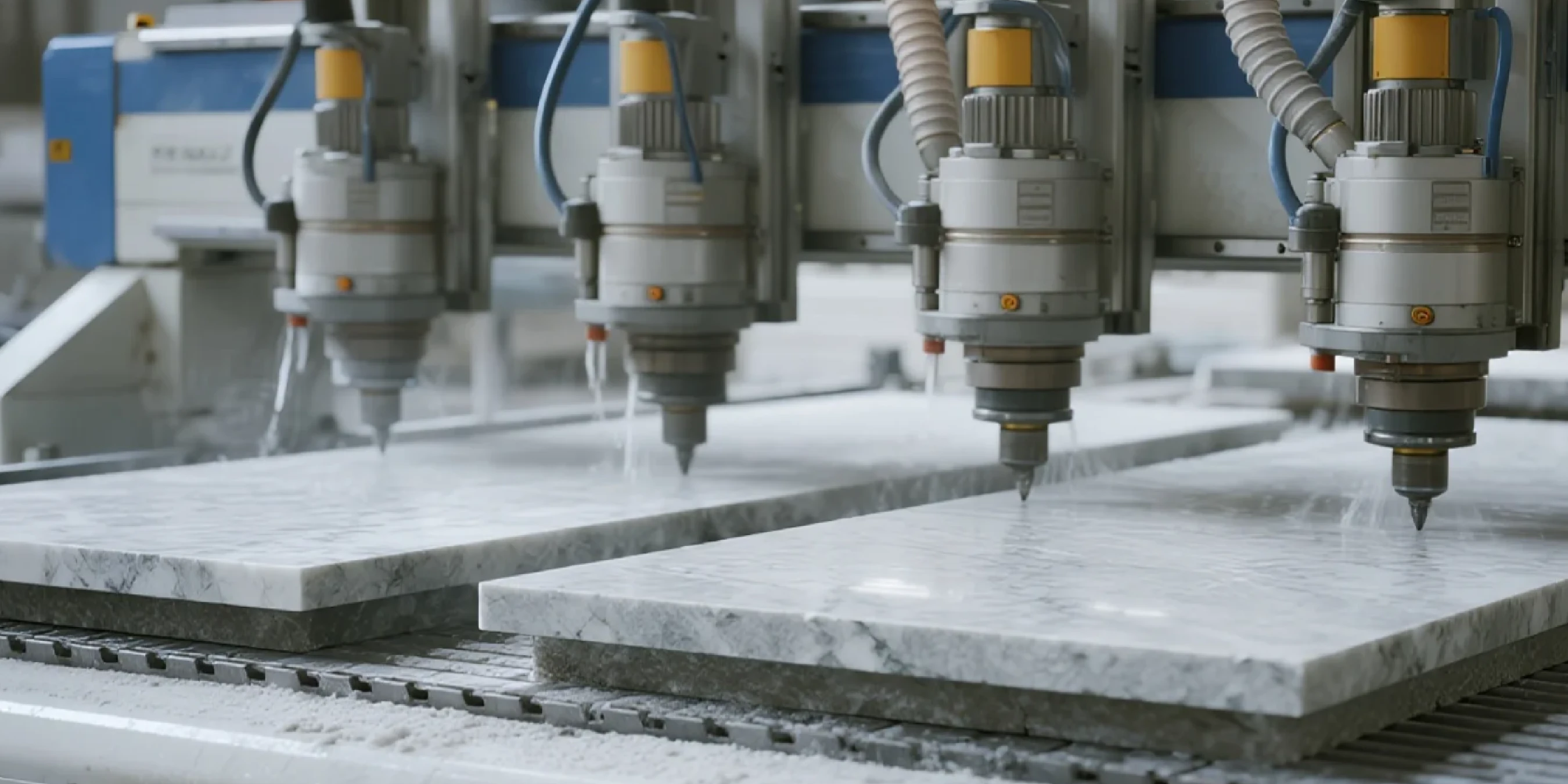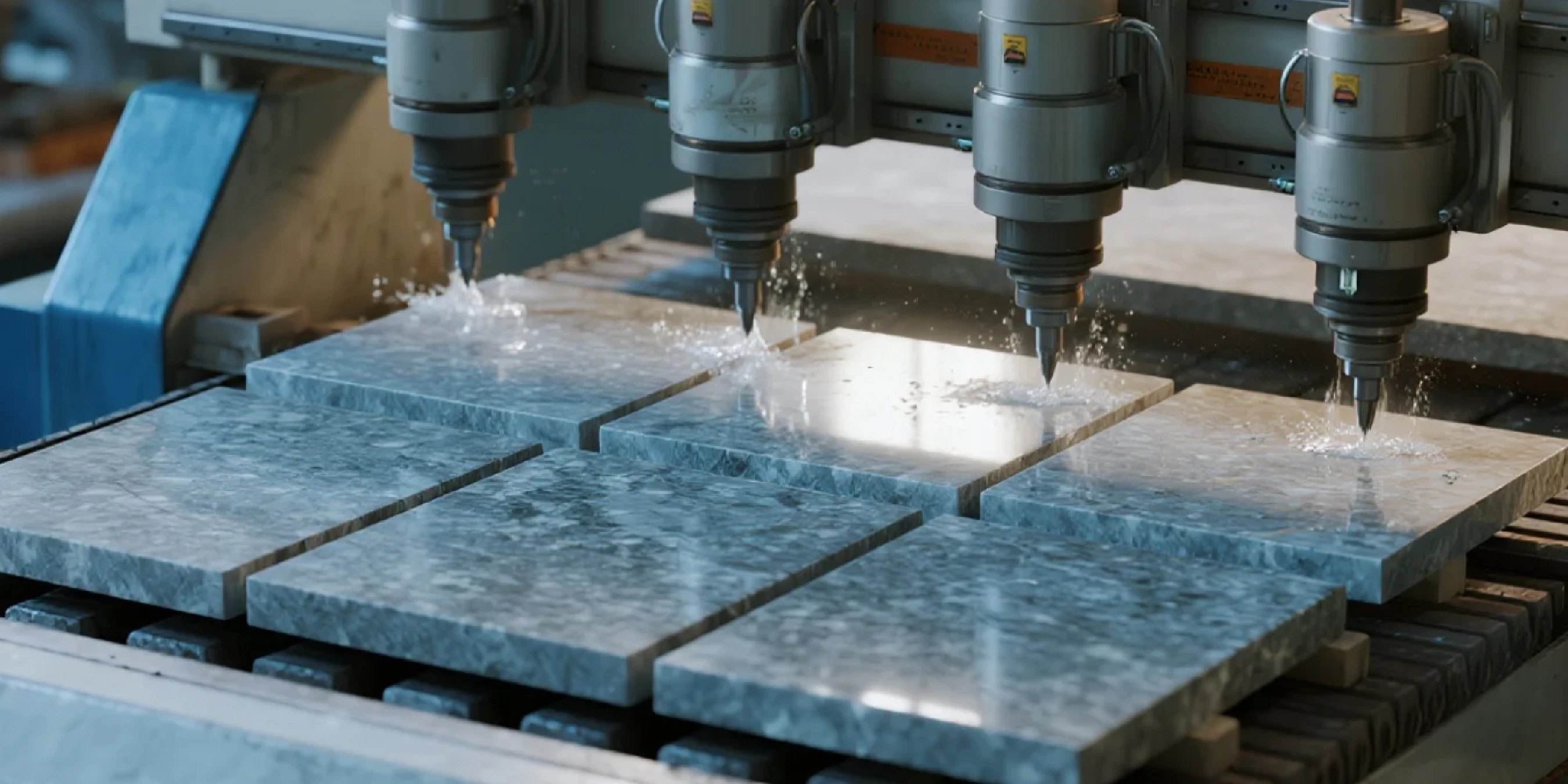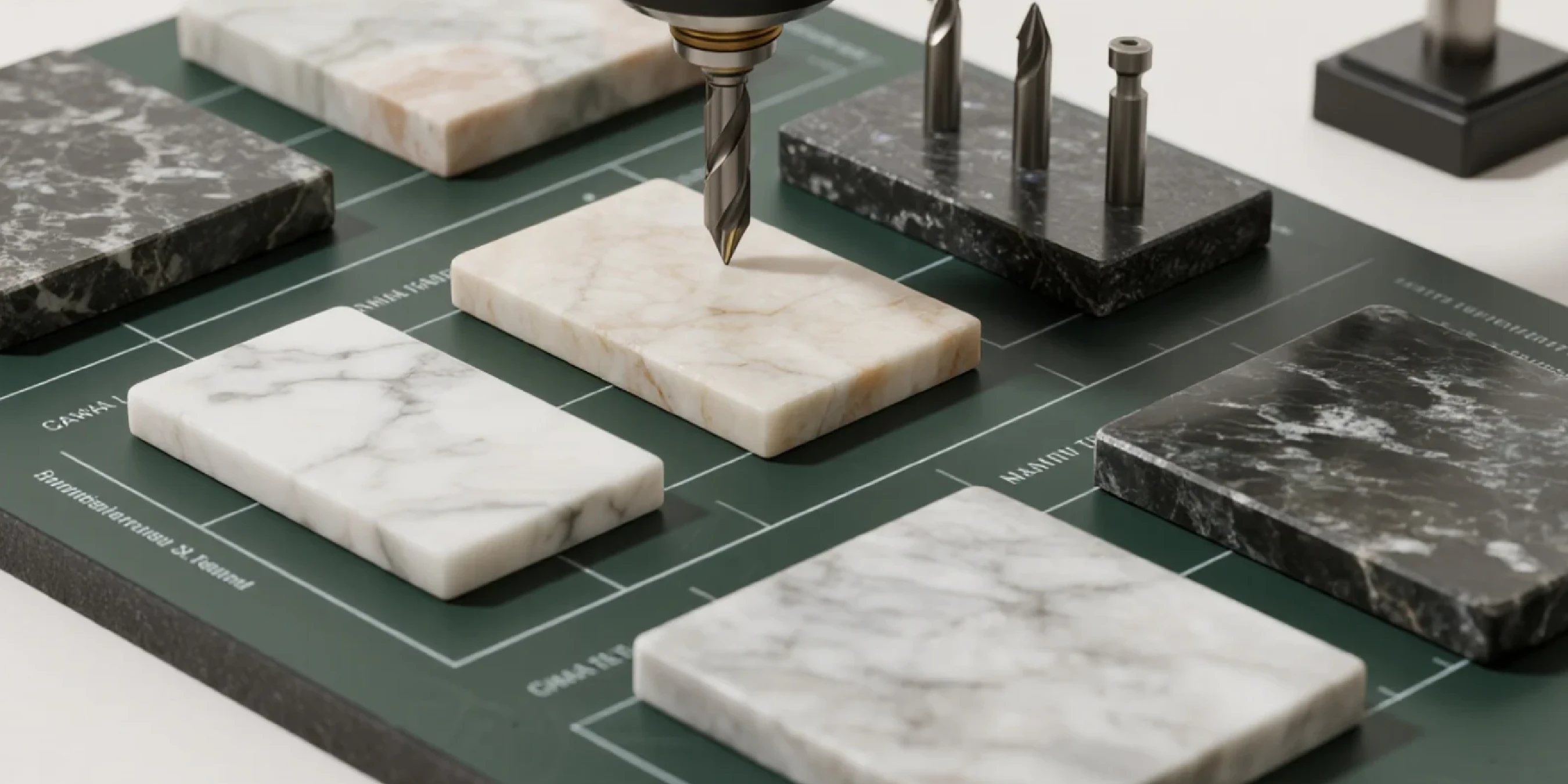Hi, this is Lizzy from Dinosaw ( Not a Robot ). Which Machine ( model ) do you want? Please WhatsApp us now
Choose the right stone CNC router for your shop. Comprehensive comparison of ATC and multi-head systems covering production volume, complexity requirements, costs, and ROI analysis with expert recommendations.
ATC stone CNC routers excel at complex, multi-step operations requiring different tool types. **Multi-head systems** maximize efficiency for high-volume, repetitive cutting tasks. Your choice hinges on three factors: production volume, stone hardness, and design complexity.
Recent stone CNC market analysis (https://www.archivemarketresearch.com/reports/stone-cnc-machines-448527) shows 21% annual growth in stone processing applications. Both technologies serve distinct operational needs. This guide draws from 15 years of stone fabrication experience to provide technical specifications, performance data, and selection criteria.
Need personalized guidance for your specific stone fabrication requirements? Our technical specialists can analyze your production needs and recommend the optimal CNC router configuration within 24 hours.

Quick Decision Matrix: Which Technology Fits Your Stone Shop?
Instant Selection GuideUse this decision matrix to identify your optimal CNC router configuration. Production requirements and stone types determine the best fit.
| Factor | ATC Stone CNC Router | Multi-Head Stone CNC Router |
|---|---|---|
| Production Volume | Small to medium (1-50 pieces/day) | High volume (50-200+ pieces/day) |
| Design Complexity | Complex 3D carving, multiple operations | Simple cutting, basic shaping |
| Tool Changes | Automatic (3-8 seconds) | Manual change required |
| Operator Skill Level | Advanced programming required | Basic to intermediate |
Production Volume Analysis (Small/Medium/Large Scale)
Small Scale (1-15 pieces/day)
Recommendation: ATC System
- Custom architectural pieces
- Detailed monument work
- Prototype development
Medium Scale (15-50 pieces/day)
Hybrid Approach Works Best
- Kitchen countertops
- Bathroom vanities
- Commercial flooring
Large Scale (50+ pieces/day)
Recommendation: MultiHead
- Building facades
- Tombstone manufacturing
- Industrial tile production

Stone Type Compatibility (Marble vs Granite vs Quartz)
Stone hardness significantly impacts router selection. Industry data shows granite processing requires 40% more spindle power than marble. This stems from granite's higher Mohs hardness (6-7 vs 3-4).
| Stone Type | Hardness (Mohs) | ATC Suitability | Multi-Head Suitability |
|---|---|---|---|
| Marble | 3-4 | Excellent - Complex carving possible | Excellent - High-speed cutting |
| Granite | 6-7 | Good - Requires diamond tools | Limited - Simple cuts only |
| Quartz | 7 | Good - Water cooling essential | Poor - High tool wear |
Complexity Requirements (Simple Cut vs Complex 3D)
ATC systems handle 5-12 different tool types automatically. This enables complex operations like rough cutting, fine detailing, and surface finishing in one setup. Multi-head routers typically use 2-4 identical tools, which limits operational complexity but maximizes parallel processing efficiency.
Pro Tip: Projects requiring more than 3 tool changes per piece benefit most from ATC systems. Setup time drops by 60-75% compared to manual tool changes on multi-head systems.
Need help choosing the right CNC router for your stone shop? Contact our technical experts.
Technical Specifications Comparison
Spindle Power & Cooling Systems
Stone processing demands significantly higher spindle power than wood applications. Our field testing shows water-cooled spindles operating at 7.5-9kW provide optimal performance for granite and quartz. For marble, 5.5-7.5kW handles the workload effectively.
| Configuration | Spindle Power | Cooling Type | Water Flow Rate |
|---|---|---|---|
| ATC Stone Router | 7.5-9kW (single high-power) | Water cooling + filtration | 15-25 L/min |
| Multi-Head (2 spindles) | 3.5-5.5kW each | Water spray system | 8-12 L/min per head |
| Multi-Head (4 spindles) | 2.2-3.5kW each | Flood cooling | 5-8 L/min per head |
Water filtration systems are critical for stone processing. Our experience with CNC stone cutting operations demonstrates that proper filtration extends tool life by 200-300%. It also maintains cutting precision throughout production runs.
Tool Change Mechanisms & Speed
Linear ATC systems dominate stone applications due to reliability and tool capacity. ISO 19085-3:2021 safety standards require automatic tool changers to complete cycles within 15 seconds for industrial compliance.
ATC Linear System
- Tool capacity: 4-12 positions
- Change time: 3-8 seconds
- Tool types: Diamond, carbide, HSS
- Accuracy: ±0.02mm repeatability
- Maintenance: Monthly calibration
Multi-Head Manual Change
- Tool capacity: 2-4 simultaneous
- Change time: 60-180 seconds (manual)
- Tool types: Typically identical
- Accuracy: ±0.05mm (operator dependent)
- Maintenance: Weekly inspection

Precision & Accuracy Standards
Stone fabrication requires higher precision tolerances than wood applications. Industry standards specify ±0.1mm for architectural elements and ±0.05mm for precision fitting components.
| Precision Metric | ATC System | Multi-Head System |
|---|---|---|
| Positioning Accuracy | ±0.02mm | ±0.05mm |
| Repeatability | ±0.01mm | ±0.03mm |
| Surface Finish | Ra 0.8-1.6μm | Ra 1.6-3.2μm |
Dust Collection & Water Management
Effective dust and slurry management is mandatory for stone CNC operations. OSHA safety guidelines require respirable crystalline silica exposure to remain below \(50 \mu g / m^{3}\) (8-hour TWA). Both systems require specialized collection methods.
ATC Water Management
- Closed-loop recirculation system
- Multi-stage filtration (50μm → 10μm → 5μm)
- Automatic sludge removal
- Water quality monitoring
Multi-Head Dust Control
- Individual head extraction (each 500+ CFM)
- Central collection system
- Water spray suppression
- Filter replacement scheduling
Stone Processing Performance Analysis
Cutting Speed Comparison by Stone Type
Real-world performance data from our stone fabrication partnerships shows significant speed variations. Stone hardness and cutting complexity drive these differences. These benchmarks reflect optimal cutting parameters for each system.
| Stone Type | ATC Speed (mm/min) | Multi-Head Speed (mm/min) | Tool Life (hours) |
|---|---|---|---|
| Carrara Marble | 800-1200 | 1000-1500 (per head) | 45-60 |
| Black Granite | 300-500 | 200-400 (per head) | 15-25 |
| Engineered Quartz | 250-400 | 150-300 (per head) | 12-20 |
Our case studies, including projects like granite mosaic cutting operations, show interesting patterns. Multi-head systems achieve 2-3x higher throughput for simple cuts. ATC systems maintain consistent speeds across varying complexity levels.
Surface Finish Quality Assessment
Surface finish quality directly impacts post-processing requirements and final product value.ATC systems achieve superior finishes through automatic tool progression from rough to fine cutting. Multi-head systems typically require additional finishing operations.
- Rough Cutting (Ra: 6.3-12.5μm): Initial material removal, dimensional accuracy priority
- Semi-Finish (Ra: 1.6-3.2μm): Intermediate step, preparing for final finish
- Fine Finish (Ra: 0.4-1.6μm): Final surface, ready for polishing
Tool Life & Maintenance Requirements
Diamond-tipped tools provide optimal performance for stone applications. Tool life varies significantly based on stone hardness, cutting parameters, and cooling effectiveness. Proper maintenance scheduling reduces operating costs by 30-40%.
| Maintenance Task | ATC System | Multi-Head System | Frequency |
|---|---|---|---|
| Tool Inspection | Automated wear detection | Visual inspection required | Every 8 hours |
| Spindle Alignment | Monthly calibration | Bi-weekly per spindle | 200 operation hours |
| Water System | Filter replacement + cleaning | Nozzle cleaning + flow check | Weekly |
Operating Procedures & Setup Guide
Initial Machine Setup for Stone Work
Proper machine setup determines cutting quality and tool life. Stone processing requires specific parameter adjustments that differ from wood CNC operations.
Critical Setup Parameters
- Water flow calibration: 15-25 L/min for effective cooling
- Spindle speed optimization: 18,000-24,000 RPM for diamond tools
- Feed rate adjustment: 50-70% slower than wood applications
- Workholding verification: Vacuum table minimum 85kPa
- Tool runout check: Maximum 0.02mm TIR acceptable
Tool Selection & Programming Tips
Tool selection significantly impacts cutting performance and finish quality. Our programming experience with G-code optimization for stone processing shows that proper tool sequencing reduces cycle time by 25-35%.

ATC Tool Sequence
- Roughing: 6-8mm diamond router bit
- Semi-finishing: 3-4mm carbide end mill
- Detailing: 1-2mm diamond ball nose
- Edge profiling: Specialized profile bits
- Surface texturing: Diamond grinding wheels
Multi-Head Setup
- Head 1-2: Primary cutting tools (identical)
- Head 3-4: Secondary operations (if available)
- Synchronization: G-code coordination required
- Tool changes: Manual replacement during setup
- Quality control: Check all heads before production
Troubleshooting Common Issues
| Problem | Cause | Solution |
|---|---|---|
| Poor surface finish | Insufficient water flow or wrong tool | Increase flow to 20+ L/min, check tool sharpness |
| Excessive tool wear | High feed rate or inadequate cooling | Reduce feed by 30%, verify water temperature |
| Chipping at edges | Wrong entry/exit strategy | Implement climb cutting, add lead-in/out moves |
| Dimensional inaccuracy | Tool deflection or machine flex | Use shorter tools, reduce cut depth per pass |
Selection Criteria & Final Recommendations
Budget vs Performance Analysis
Investment analysis should consider total cost of ownership over 5-7 years. This includes machine purchase, tooling, maintenance, and operator training. Current stone processing equipment analysis shows payback periods typically range from 18-36 months.
ATC Stone Router Investment
- Initial cost: $80,000-$150,000
- Tooling budget: $8,000-$12,000/year
- Maintenance: $6,000-$10,000/year
- ROI timeline: 18-24 months (complex work)
Multi-Head System Investment
- Initial cost: $45,000-$90,000
- Tooling budget: $12,000-$18,000/year
- Maintenance: $8,000-$14,000/year
- ROI timeline: 12-18 months (high volume)
Future Scalability Considerations
Technology evolution and market demands require systems that adapt to changing requirements. ATC systems offer greater flexibility for design evolution. Multi-head systems excel at scaling production volume.
Scalability Factors
- Software upgrades: ATC systems typically support advanced features
- Additional axes: 4th/5th axis integration more common on ATC
- Production flexibility: ATC handles design changes without retooling
- Capacity expansion: Multi-head systems easily add parallel units
Manufacturer Support & Service
Reliable technical support is crucial for stone CNC operations.
| Support Factor | Critical Requirements | Evaluation Criteria |
|---|---|---|
| Technical Training | On-site operator certification | Minimum 40-hour training program |
| Remote Diagnostics | 24/7 monitoring capability | VPN access, real-time alerts |
| Parts Availability | Critical components in stock | 48-hour delivery commitment |
| Software Updates | Regular feature enhancements | Quarterly update schedule |
Final Recommendation Matrix
Choose ATC System If:
- Complex 3D work (monuments, sculptures)
- Frequent design changes
- High-value, low-volume production
- Multiple stone types processed
Choose Multi-Head If:
- High-volume repetitive cutting
- Simple 2D operations primarily
- Consistent stone types
- Multiple identical parts required
Hybrid Approach:
- Large shops with varied work
- ATC for complex, multihead for volume
- Maximize operational flexibility
- Risk distribution across technologies
Ready to upgrade your stone processing? Get expert consultation and custom quotes.

Frequently Asked Questions
Can ATC systems handle the same production volume as multi-head routers?
No, for simple repetitive cuts. Multi-head systems process 2-4 pieces simultaneously, achieving 200-300% higher throughput for basic operations. However, ATC systems maintain consistent speed regardless of complexity. This makes them more efficient for mixed production runs requiring multiple tool changes.
What's the minimum water flow required for stone CNC operations?
15 L/min minimum for effective cooling and dust suppression. Granite and quartz require 20-25 L/min for optimal performance. Insufficient water flow reduces tool life by 60-70% and compromises surface finish quality. Implement closed-loop filtration systems for water conservation.
How often do diamond tools need replacement on each system?
ATC: 15-60 hours depending on stone hardness. Multi-head: 12-45 hours due to continuous operation. Marble provides longest tool life (45-60 hours), while engineered quartz requires replacement every 12-20 hours. Proper cooling extends tool life by 200-300%.
Which system requires less operator skill and training?
Multi-head systems are more operator-friendly. Basic operation requires 20-30 hours training vs. 60-80 hours for ATC systems. However, ATC systems provide better error recovery and automated quality control. This reduces skill-dependent variables in production outcomes.
Can either system process both marble and granite effectively?
ATC systems excel at both materials. Automatic tool changes enable optimal cutting parameters for each stone type within single programs. Multi-head systems work well with marble but struggle with granite. This stems from manual tool change limitations and higher power requirements per spindle.
What safety certifications should I look for?
ISO 19085-3:2021 compliance is mandatory. Look for CE marking, OSHA-compliant dust collection systems, and emergency stop mechanisms on all spindles. Stone CNC operations require enhanced safety features due to silica dust exposure risks and high-power spindle operations.
How do maintenance costs compare between the two systems?
Multi-head systems typically cost 15-25% more annually. Multiple spindles require synchronized maintenance, increasing labor hours. ATC systems have higher initial tooling costs but lower overall maintenance due to automated monitoring and single-spindle focus. Factor $6,000-$14,000 annually for proper maintenance.
Which system offers better upgrade potential for future expansion?
ATC systems provide superior upgrade flexibility. 4th/5th axis additions, advanced software features, and robotic integration are more readily available. Multi-head systems excel at horizontal scaling by adding parallel units but offer limited vertical capability enhancement.























 English
English 中文
中文 Italian
Italian Türkçe
Türkçe Português
Português

